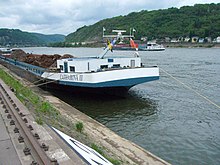Coupling bandage
A coupling formation is a combination of a motor ship and up to three push barges with a total load capacity of up to 10,000 tons. From a nautical and legal point of view, the coupling convoy in a longitudinal formation counts as a pushed convoy, also in combination with several barges.
development
At the same time as the development of pusher shipping , the first coupling convoys also started moving. For this purpose, barges and motor ships were equipped with push platforms to connect the two ships. With the help of coupling winches on the moving platforms, an almost rigid connection was made. In the first few years these paddocks drove coupled to each other to the mountain and side by side to the valley. In the 1980s, special coupling convoys were built in which both ships were fluidically coordinated. Either the motor ship was given a rectangular, flat bow ( box bow ), so that there was no space between the ship and the stern of the lighter, or on ships with a normal bow, the stern of the lighter is designed in a dovetail shape into which the bow of the motor ship fits. However, the box bow has a disadvantageous effect on the driving resistance when the motor ship is sailing without a barge. Both units of the coupling formations now have ballast systems with which the ships can be brought to the same draft .
The barges are equipped with bow thrusters , with which they can also make small changes in location. Some barges also have an apartment. Coupling units are used in tank and dry shipping.
Various techniques are available today to connect the two ships. In addition to the old coupling winches, there are also automatic couplings or hydraulic couplings that allow the formation to be angled (buckling) by up to twelve degrees in order to better navigate tight river bends.
Technical specifications
Example of a motor ship Catharina / barge Catharina II in common use today
- Length = 182.0 m, motor ship = 96.0 m, lighter = 86.0 m
- Width = 14.26 m
- Draft = 4.21 m
- Load capacity motor ship = 4,266 t, lighter = 3,880 t, 271/267 TEU in five layers
- 2 × MTU / DDC 12V 4000 M 60 each 1,176 kW main engine
- 1 × MTU 8V M 60, 400 kW bow thruster
- 1 × MTU 8V M 60, 400 kW rudder propeller lighter
- 1 × MTU 12V 2000 M 60, 600 kW bow thruster lighter
- 2 × generator sets each 50 kVA
- 2 × generator sets each 75 kVA
Today's paddocks always ride in a stretched formation. The largest coupling association (2010) on the Rhine, Ursa Montana , has a length of 194 m and a width of 17.28 m. The deadweight is 10,388 tons or 712 TEU at a draft of 4.11 m. The Prinses Máxima in the Netherlands and the Province de Liège in Belgium are used to train these associations .




